2025 TESA Nominees
For over 26 years, The Environmental Stewardship Award (TESA) has recognized beef producers who explore innovative ways to protect, preserve, and enhance their operations and the environment simultaneously. These producers go above and beyond in their efforts to exemplify significant innovation and attention to a wide range of environmental aspects in their operations.
Meet this year’s regional recipients, who will compete at the national level and are invited to attend the CCA semi-annual meeting which will be held in Levis, Quebec, September 9-11. The most outstanding regional nominee will be recognized as the National Environmental Stewardship Award recipient. We’d like to thank our long-standing TESA judges from Ducks Unlimited Canada, Alberta Conservation Association (ACA), and Cows & Fish as well as past TESA recipients.
The Canadian Cattle Association (CCA) is proud of the significant amount of work being done by cattle producers across Canada to improve sustainability and environmental stewardship and commends the efforts of all TESA nominees.
Thank you to our Platinum Sponsor, MNP and Foundation Partners, Ducks Unlimited, Birds Canada, and the Canadian Roundtable for Sustainable Beef (CRSB).
British Columbia – Barnett Land and Cattle, Duncan & Jane Barnett
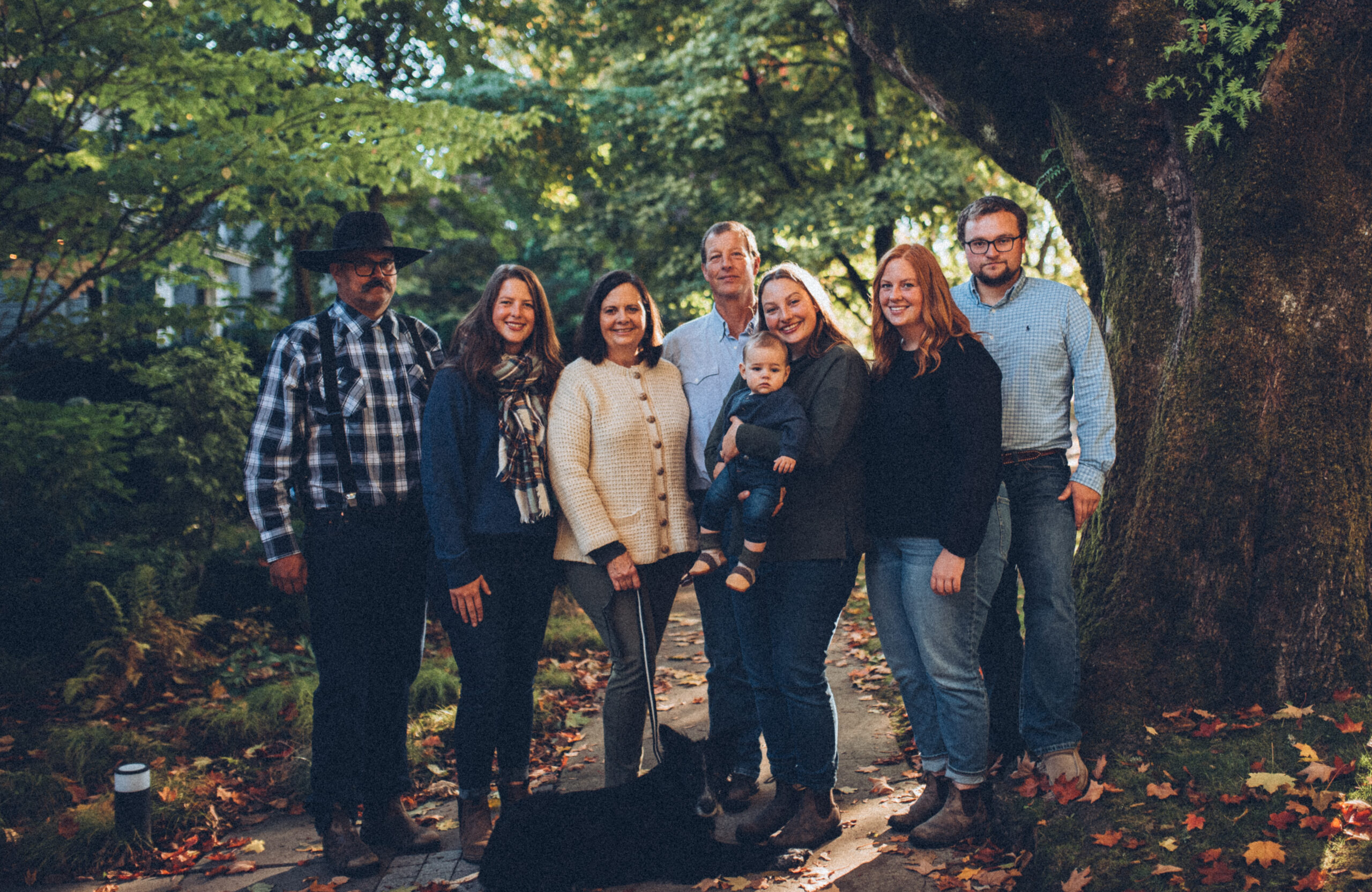
Duncan and Jane Barnett, who operate Barnett Land and Cattle along the Cariboo Gold Rush Trail in British Columbia, have been selected as the province’s 2025 Environmental Stewardship Award nominee. The VBP+ operation has 100 Angus-influenced cows that are “healthy, happy and productive” according to Duncan. The farm also does some custom feeding and sells hay.
Barnett Land and Cattle have made substantial changes to help protect vulnerable ecosystems in their operation. To limit disruption to riparian areas, they use electrical fences to block them and portable solar water buggies to supply the herd with water. Through the environmental farm plan, they also added frost-free nose pumps in several locations to water cattle when grazing and in winter feeding areas. Barnett Land and Cattle was the first operation in BC to use the nose pumps, and the original pumps are still in use today.
The Barnetts believe that cattle are an essential tool to advance their land and expand their electric fences for an intensive rotational grazing system. Their experience with the Invasive Plant Council aided them in tailoring a strategy to control Oxeye daisy, Rattlebox, hawkweed, and burdock through grazing. In the winter, the operation rotates winter feeding areas to strategically distribute nutrients and organic matter to certain areas. Barnett Land and Cattle has also seen several wild birds return to the farm including Loons, Swans, Blue Heron, Hawks and Sandhill cranes come to the lakes and perch on Duncan’s “rock dock”.
The Barnetts also put effort into developing progressive and innovative forest and fire management plans. Developed in conjunction with UBC Forest Research, the operation collected forest values to better understand their land base and determine which areas are best suited for agriculture, future harvest, or aesthetics. They focus on completing “Firesmart” work by removing dead trees and deadfall close as well as clearing fence lines for forest and fire access. After a close call fire in 2022, the Barnetts also expanded their stack yard to create a buffer zone to protect their feed in case of a fire.
To Learn more about Barnett Land and Cattle, click HERE.
Alberta – Plateau Cattle Co., Laura Laing & John Smith
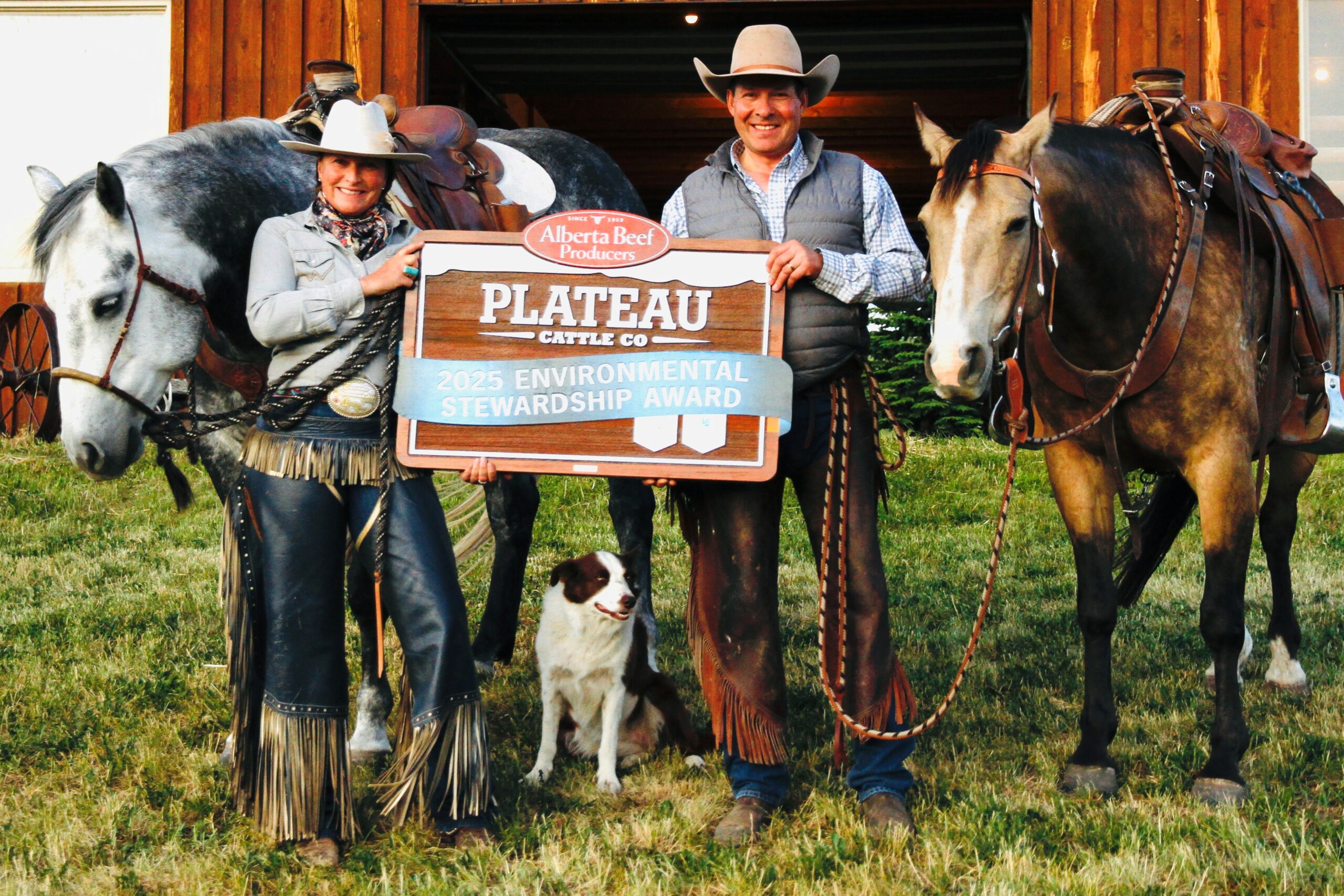
Laura Laing and John Smith of Plateau Cattle Co have been recognized by the Alberta Beef Producers as The Environmental Stewardship Award recipient for Alberta for 2025. The operation close to Nanton, AB runs 450 highly efficient and functional purebred Black Angus and Angus-influenced cows. When evaluated, more than 40 percent of their calf crop graded Prime, while the other 60 percent graded AAA. For multiple generations, the operation has been focused on sustainable practices that help enhance the cattle and land.
When handling cattle, John and Laura uphold the core values of respect, compassion, care, and kindness to such a degree that these principles are prominently displayed on the pillars of the processing barn. Inspired by many of Dr. Temple Grandin’s ideas, the operation added mats to the squeeze chute to help stimulate deep pressure sensation when processing calves. From this practice and moving away from hot branding, they have seen a weaning weight improvement of +18 pounds.
Plateau Cattle Co has also been at the forefront of innovative animal health and herd management practices including having a custom vaccination protocol to reduce the need for antimicrobial use as well as transitioning the calving period to April and using a Sandhills calving system to reduce the risk of disease. Dewormers on the operation are only used when medically relevant which helps reduce drug residues that kill dung beetles that play an important role in manure breakdown.
When open pit coal mining threatened the eastern slopes, John and Laura shared their voice as stewards of the land to protect native grasslands and natural waterways. As producers, they work with many wildlife organizations to improve wildlife management by introducing a livestock guardian dog to deter predators and removing deadstock by a rendering truck. They also fence off riparian areas that help protect wildlife habitat.
John and Laura have been strong members of the community and community groups. In 2018, Plateau Cattle Co helped install an internet tower which help advance the whole community. John is the current vice chair of Waldron Grazing Cooperative and a member of many other livestock boards. In conjunction with the University of Guelph and the Youth in Ag Mentorship program, Plateau Cattle Co has hosted multiple students to gain hands-one experience in agriculture.
To learn more about Plateau Cattle Co., Click HERE.
Saskatchewan – Elford Ranch, Mark & Karin Elford
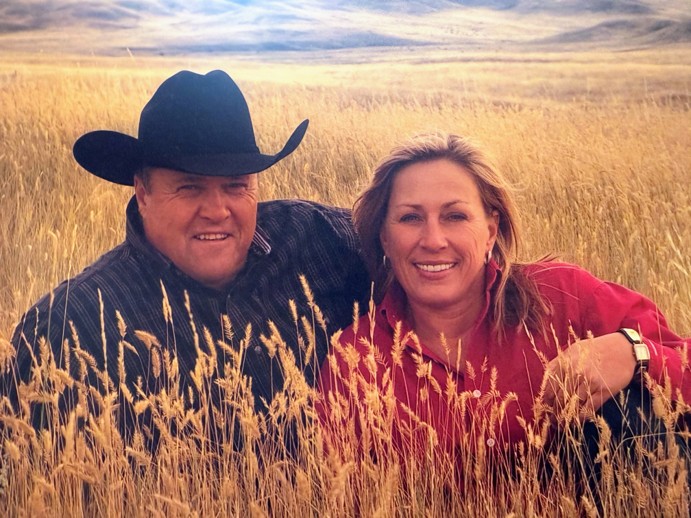
Mark and Karin Elford along with their family operate the Elford Ranch located south of Killdeer, SK. Mark has been a steward of land since high school when he bought his first quarter of land. He ranches with a strong respect for the land and the importance of understanding its diversity. The Saskatchewan Stock Growers Association recognized their commitment to the grasslands and awarded the family the 2025 SSGA Environmental Stewardship Award.
Elford Ranch has approximately 33 quarters totalling about 4,800 acres of native grassland and 500 acres of tame grass. The Ranch is located in the dry mixed grassland region of brown soil zone where four unique ecosites have been identified. Mark recognizes that each ecosite has distinct plant and soil characteristics that he takes into consideration when deciding grazing patterns and overall management decisions.
Mark’s grassland management philosophy is “the grass looks after the cattle and the rancher, not the other way around”. Many of his management strategies envelope the idea of “giving more than you take”. As well, Mark advocates seeking advice from others stewards as this helps build and strengthen the community.
Mark has been involved in multiple cattle groups throughout the years. He was an SSGA Board member as well as previous chairs of Canadian Cattle Identification Agency (CCIA), Livestock Services Saskatchewan (LSS) and the Saskatchewan Cattlemen’s Association (SCA). Members of his community note that he always speaks humbly to other producers and is a strong leader that leads by example.
To learn more about Elford Ranch, click HERE.
Manitoba – Breault Ranching Ltd., Clayton & Shauna Breault and Family
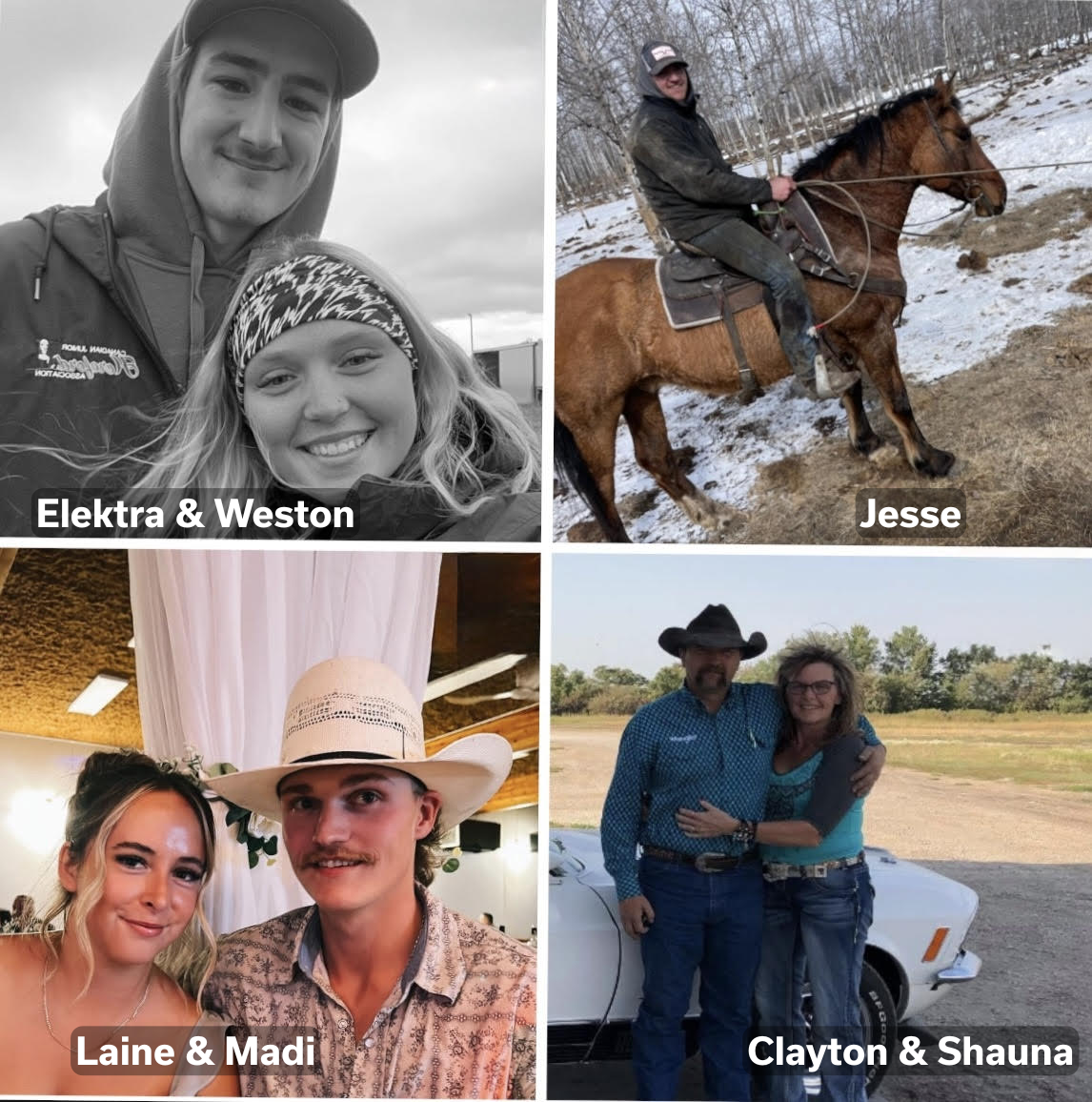
Breault Ranching Ltd., located north of Ste. Rose near Toutes Aides, Manitoba, is dedicated to improving soil health through the six principles of regenerative agriculture. Clayton and Shauna Breault, along with their children, manage a herd of 4,300 head across 22,000 acres of pasture. Notably, 16,000 acres of this land consists of agricultural crown land grazing leases. The Manitoba Beef Producers (MBP) awarded Breault Ranching with the MBP TESA award at the MBP AGM in February 2025.
Breault Ranching has focused on multiple sustainable principles to improve soil health and productivity. For example they have implemented zero-tillage management across their land base to reduce the amount of physical soil disturbance and maintain the soil’s integrity. Also, they have reduced overall inputs including pesticides and herbicides to support the soil’s diverse flora and fauna. Breault Ranching has moved completely away from the use of synthetic fertilizer and instead utilizes the natural property of returning nutrients to the soil through cattle. This change has not reduced land productivity and instead increased or maintained its yield and quality.
Over time, Breault Ranching has pushed the herds’ calving date to June 1st which allowed the cattle to utilize the diverse diet of forages during the spring/summer season. The operation has seen the quantitative success of this practice by observing a reduction of calves treated after weaning from 10% down to 1%. The operation utilizes a rotational grazing system across 137 paddocks to evenly distribute grazing pressures and improve carbon sequestration (compared to conventional grazing). Their strong restorative land management practices have seen results such as more than doubling the organic matter in the soil from 2.3 to 6.8.
Clayton and Shauna demonstrate their progressive perspective through the quote, “We consider our ranch’s commitment to regenerative agriculture to be a learning, adaptable journey.” Breault Ranching highlights that commitment through a willingness to collaborate with strong community organizations like Understanding Ag, Holistic Management Canada, Manitoba Forage and Grassland Association, Environmental Farm Plan, Verified Beef Plus, and EU certified. They continue to learn and engage in the sustainability sphere.
To learn more about Breault Ranching Ltd., Click HERE.
Ontario – Van Osch Farm Ltd.
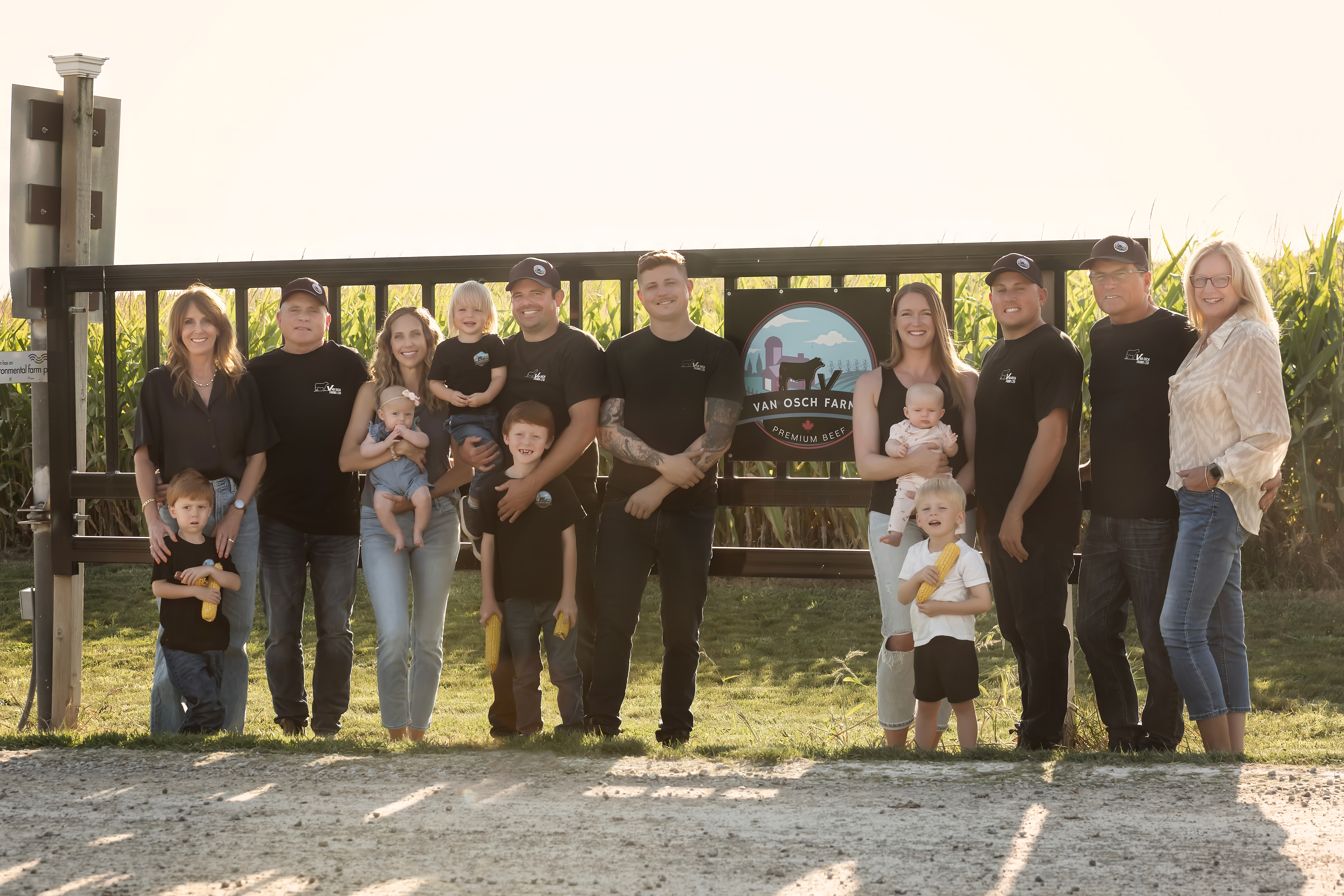
Van Osch Farms, located in Middlesex County is diligently operated by Fred, Gerald, Brendon and Kurt Van Osch who run the operation with an 11,500-capacity feedlot as well as 10,000 acres of land. The operation is proud to be certified with the Canadian Roundtable for Sustainable Beef (CRSB) as well as the Ontario Corn Fed Beef Quality Assurance Program.
The operation continues to expand into new technology and innovative management strategies. Notably, they have installed solar panels across the operation to provide enough power for 80 local households and offsetting 924 tonnes of carbon emissions. The operation worked with Ausable Bayfield Conservation Authority (ABCA) to help plant 1,000 trees across the operation developing multispecies shelter belt providing habitat for wild animals. When designing their barn, they included architecture that enhances natural lighting and ventilation across the barn. In addition, concrete floors were grooved in the barn to reduce the risk of injury for animals
From a crop standpoint, the operation has continued to improve soil health through regenerative practices. Planting cover crops has become a part of their standard practice and continues to improve the soil’s water holding capacity and prevent run-off. The operation also is very purposeful with their manure management and views it as a valuable nutrient source. When it comes animal health and nutrition, Van Osch Farms are passionate about cattle’s role as “upcyclers”. Up to 40 percent of the ration fed includes by-products ingredients that typically would have ended up in the landfill. With the addition of data management and tracking technologies, Van Osch farms have been improving overall efficiency and sustainability by making data-driven decisions. The inclusion of feed bunk cameras has also helped reduce feed waste and improve overall efficiency.
To learn more about Van Osch Farms, click HERE.
Quebec – A l’Herbe, Frederic Lebel & Dominique Dumas
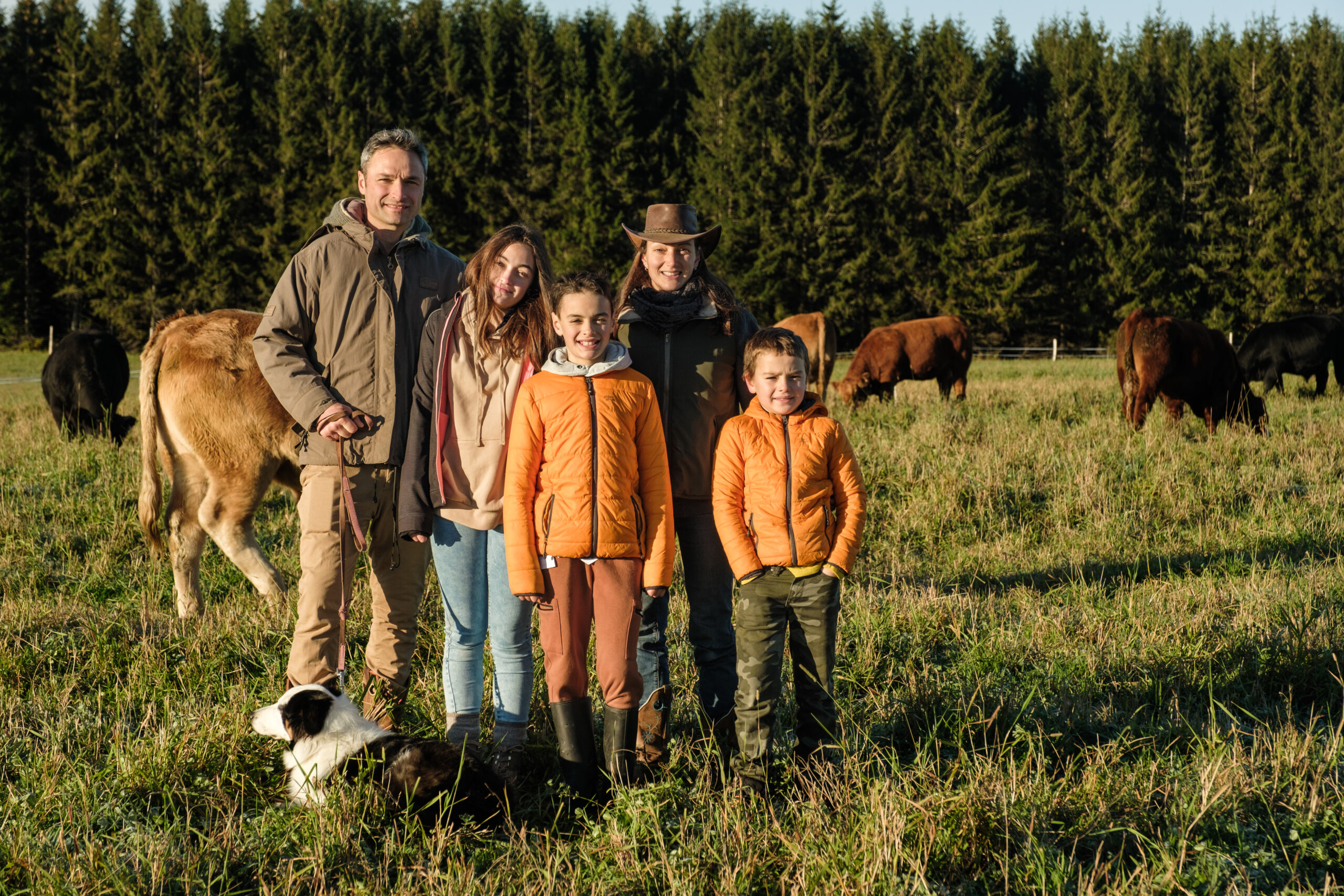
Les Producteurs de Bovins du Quebec are happy to recognize Frederic Lebel’s and Dominique Dumas’s grass-finished beef operation for the Environmental Stewardship Award (TESA) this year. The operation sits west of Quebec City and focuses on farming diversified forages along with managing 122 head of Angus-Simmental cross steers in an intensive rotational grazing system.
As first-generation producers, the pair worked diligently to convert 127 acres of annual cropland to a permanent polyculture of 12 different forage species. Through regenerative practices, the land’s productivity grew thanks to the cattle. Dominque said “the cow is a beautiful animal to regenerate the soil. The microorganisms in the cow’s digestive system work to feed the microorganisms in the soil. Every cow pie is like an inoculum that injects nutrients and new life back into the soil.”
A l’Herbe purchases yearling steers from neighbouring producers and trains them to use an electric fence. Following a four-week training period, the yearlings enter the grazing system. The farm utilizes an intensive mob grazing system where the herd is moved every four hours over the 190-day grazing season. This style of grazing benefits the cattle and the pasture as there is equal species competition due to the grazing pressure, and each yearling is getting similar nutritious bites. A L’Herbe also built custom mobile shade structures that can be positioned strategically to encourage cattle to rest and deposit waste in a particular area that requires more nutrients.
To meet consumer needs, A l’Herbe and other local producers formed a butchery co-operative. The operation started in the community supported agriculture (CSA) program and now has expanded its market to supply beef to 350 households. As well, A l’Herbe participates in the Living Lab — “Racines d’aveni” (roots of the future) project which is a five-year project to help farmers create practices to increase carbon sequestration on their operation.
To learn more about A l’Herbe, click HERE.
Maritimes – Don & Geraldine Bettle
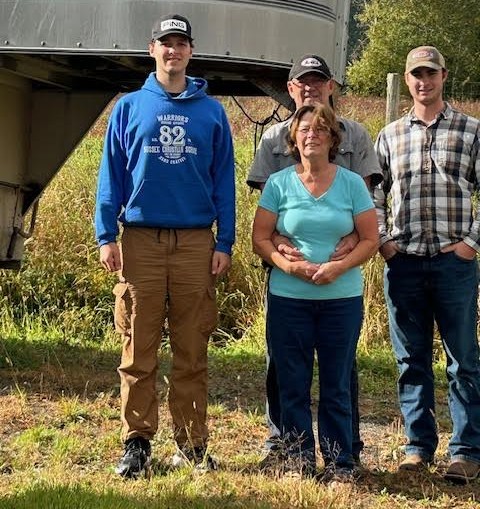
Don and his wife Geraldine Bettle have been farming for nearly 50 years at Passekeag, NB. Together, they run Passekeag Holdings Inc., a 70-head Angus-based cow herd on a land base next to the Keenebecasis River. Since Don’s youth, the river has been a vital part of the farm, inspiring his dedication to protecting the water, riparian areas, and wildlife habitat. This year, Passekeag Holdings Inc received the Maritime Beef Council’s Environmental Stewardship Award (TESA).
From the farm’s initiation, the Beetles have focused on improving the management of their land base. Their grazing system includes eight rotational paddocks that allow each piece to have 35–40 days’ rest between grazing periods. This system promotes forage regrowth and soil health. In areas where soil health is a concern, the operation often tests the soil and applies lime if necessary to improve the pH. The Beetles have also utilized winter bale grazing to restore additional nutrients to land that is sub-par. Climate change altering the lengths and temperatures of “traditional” seasons, the Bettle’s have adapted by adjusting their rotational grazing system and growing different forage species. The operation takes big strides to help protect riparian areas on the farm through organizations like Kennebecasis Watershed Restoration Committee (KWRC), New Brunswick (NB) Living labs and Ducks Unlimited Canada. With KWRC and Ducks, nearly 300 acres of wetland have been conserved and multiple native trees and shrubs species planted to stabilize the riverbank and provide shade in the ecosite. Nesting boxes and wildlife corridors have been added to the operation that in conjunction with the protection of the wetlands helps promote more biodiversity across the operation. The Bettles commitment to work with this organization is just one of the many attributes that qualified them to achieve the Maritime Beef Council’s Environmental Stewardship Award (TESA).
To Learn more about Don and Geraldine Bettle, click HERE.